Verdict
The multipurpose and omnicompetent Asus Vivobook Pro 15 has no mentionable weaknesses and is excellent value, considering its up-to-date underpinnings and range of features. Creatives, gamers, animators, modellers, and anyone just wanting a top-notch laptop will be hard-pressed to find a better one at the price.
Pros
- Colour-accurate 120Hz OLED screen
- Large, smooth touchpad with Asus DialPad
- Solid, expansive keyboard
- Room for a second SSD
Cons
- 8GB of RAM is soldered
- The I/O port layout is lopsided
Introduction
The new Asus Vivobook Pro 15 is a laptop designed for content creation and graphics-intensive productivity but with useful gaming capacity, thanks to its potent hardware.
The Vivobook Pro 15’s hardware is current, with the option of two Intel Meteor Lake-H CPUs (the Ultra 7 155H or the Ultra 9 185H) and two Nvidia RTX 4000 GPUs, the 4050 and the 4060. No matter which model you buy, you’ll get a very colourful and colour-accurate 3K (2880 x 1620) OLED panel with a 120Hz refresh rate and a MUX switch to unleash the full power of the GPU.
The price for all this tech goodness? The Core Ultra 7 155H RTX 4050 model I’ve tested won’t be ranging in the UK but will cost you $1,299 in the US. For the higher specification, which is coming to the UK, it’ll cost £1,599/$1,699. That’s not a bad price when the obvious competition in the form of Apple’s MacBook Pro 16 will set you back over £1,000 more.
Design and Keyboard
- Rock solid keyboard
- MIL-STD 810H robust
- Room for more storage and memory
The Vivobook Pro 15 is available in just one colourway in the UK, Earl Grey, which logically would be brown rather than grey. Both the colour and the design are rather anonymous. The only part of the proceedings with any glamour is the high-gloss silver Asus Vivobook script on the lid. While the lid is made from metal, the base of the Vivobook Pro 15 is plastic, but it still feels like a solid and premium product.
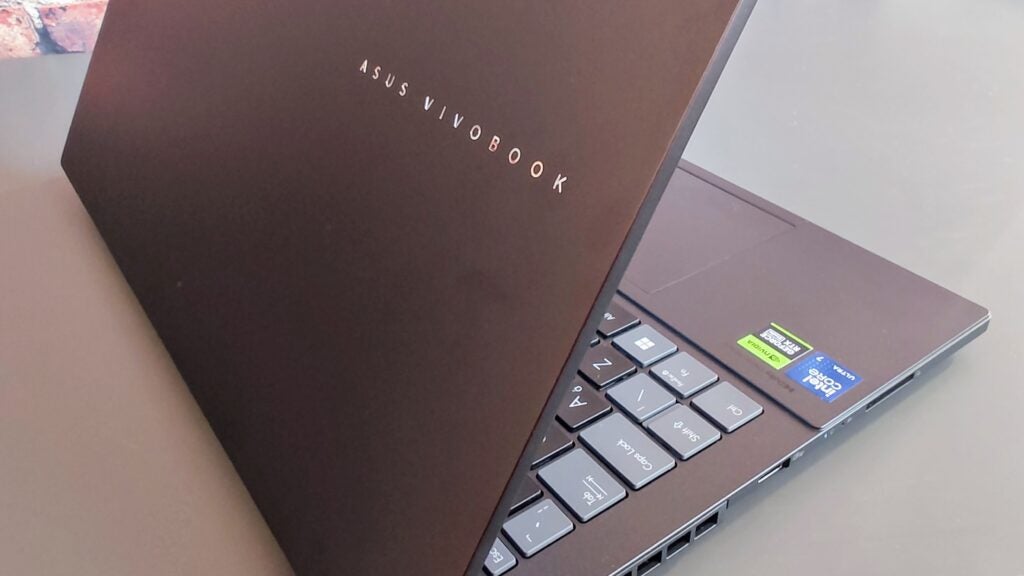
At 1.8kg the Vivobook Pro 15 is quite light, and at under 20mm thick, it is not too chunky either. Like many Asus laptops, it meets the US MIL-STD 810H standard for resistance to shock, temperature, and particle ingress.
The sides of the Vivobook Pro are home to a generous array of I/O ports. On the right are two Type-C ports, one Thunderbolt 4 spec and one USB 3.2 Gen 2, a 3.2 Gen 1 spec USB-A port, HDMI 2.1, Gigabit Ethernet, 3.5mm audio, and a power jack. On the left, there’s a second USB-A port and an SD 4.0 card reader.
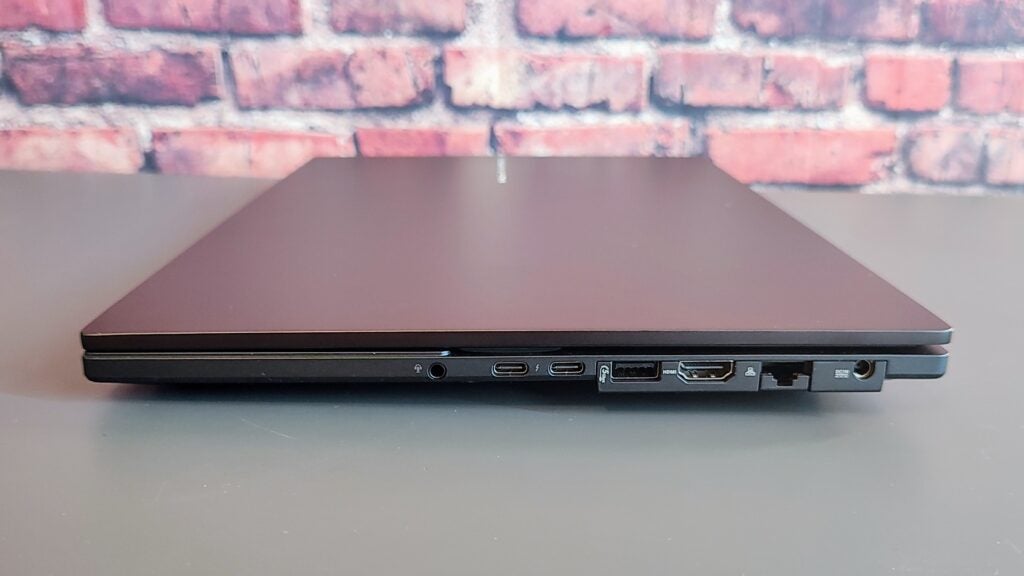
That’s a solid selection, even if the layout is unnecessarily lopsided. Only the Thunderbolt 4 port supports video output, though you can charge via either Type-C if you don’t want to carry the standard 200W Asus power brick around.
With the Intel AX211 wireless card supporting Bluetooth 5.3 and 6GHz Wi-Fi 6E, there’s no need to worry about the modernity of cable-free communications.
The first thing that strikes one about the keyboard is its solidity. You have to press down brutally in the centre to get the slightest flex from the deck. In normal use, it is effectively solid. It’s expansive, too, with a two-thirds-width numeric keyboard. If I had to pick a layout issue, I’d mention the half-height cursor keys.
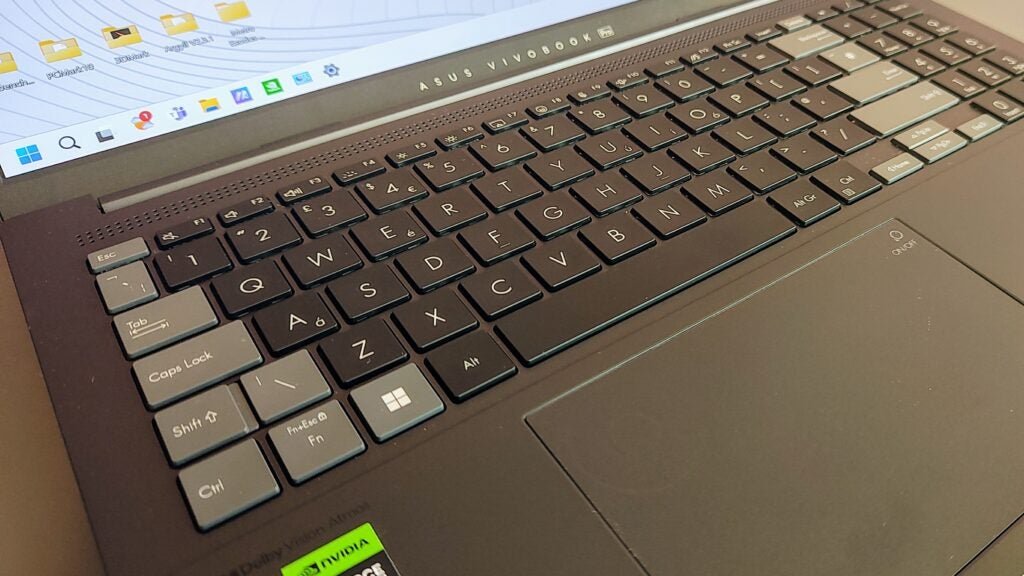
The black and grey keyboard is easy on the eye, and the colour difference between the grey enter keys, black alphanumeric keys, and numeric keypad isn’t just a question of aesthetics. I found it improved my focus on the central part of the keyboard when typing or the number pad when using that.
The keys have a perfectly judged 1.4mm travel, a comfortable 0.3 mm key-cap dish, and a clean action with a positive end stop. The typing action is silent.
The Asus DialPad is built into the top-left corner of the touchpad and activated by a swipe from the top right. If you want to know more about the DialPad, Asus has created a handy video. In short, it’s a circular controller that gives you fingertip control over your creative apps. For example, you can use it to change brush size. It’s fully customisable and can be used for mundane tasks like adjusting the volume or display brightness.
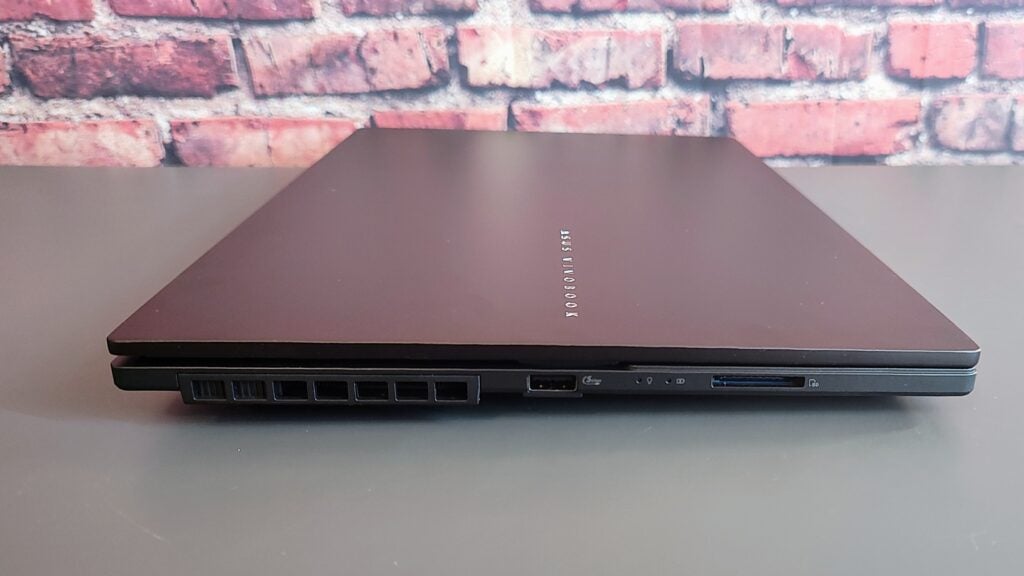
Getting inside the Vivobook Pro 15 is straightforward, and once open, you’ll find space for a second 2280 PCIe 4 SSD and one free SODIMM RAM slot. With 8GB of RAM soldered to the motherboard, you can load a maximum of another 16GB onto the Vivobook Pro taking the total to 24GB. The Intel AX211 Wi-Fi card is also easily accessible, and the battery can be replaced with just the removal of four Philips screws.
Asus makes no specific claims regarding the Vivobook Pro 15’s environmental impact or lack thereof, but the packing is minimal and made entirely of easily recycled cardboard. You can even disassemble the box lid and fashion it into an impromptu stand, holding the Vivobook Pro vertically or propping the rear up to improve the typing angle.
Display and Sound
- Colour-accurate 120Hz OLED screen
- Loud and punchy sound system
- All-singing, all-dancing webcam
The Samsung-made display is a very impressive 15.6-inch, 16:9 120Hz OLED affair. The 2,880 x 1,620-pixel panel isn’t quite as sharp as the MacBook Pro’s at 212dpi to 254dpi, but the difference is hard to discern with the naked eye. It’s bright, hitting 330nits in SDR mode and 603nits in HDR mode, earning it a VESA DisplayHDR True Black 600 award.
Colour is abundant thanks to the wide gamut coverage of 100% sRGB, 98.6% DCI-P3, and 95.3% Adobe RGB, all validated by Pantone. The display is also superbly accurate, with Delta E variances of just 0.66 vs the Display-P3 profile, 0.91 vs DCI-P3, and 0.7 vs sRGB. Those results are outstandingly good, amongst the best I’ve encountered on any laptop.
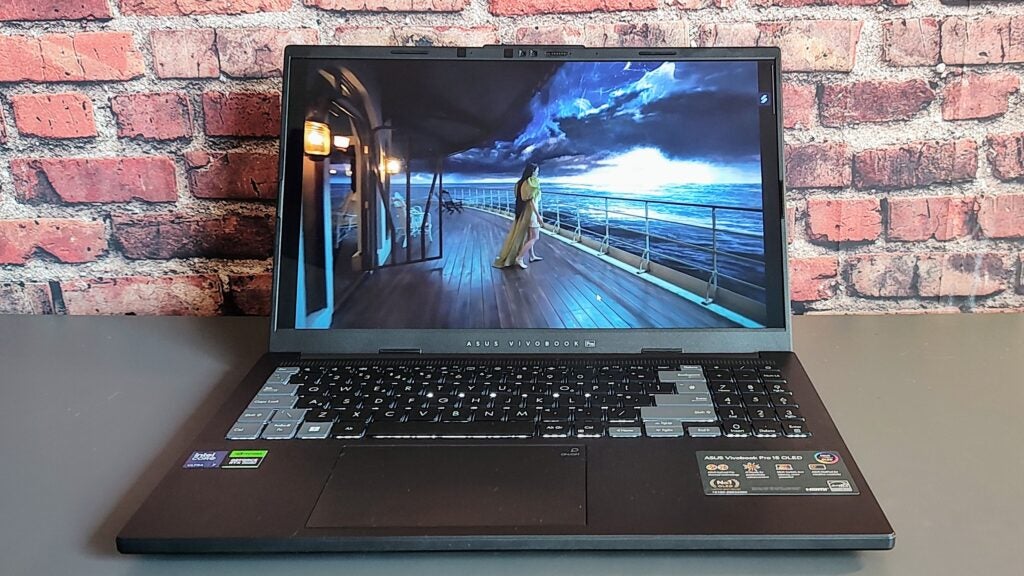
HDR performance is hugely impressive, with infinite contrast and superbly saturated colours. Whether just watching a movie or creating content, the Vivobook Pro’s display is a joy to behold, even if it can’t match the searing brightness of the MacBook Pro’s Mini LED display.
Asus claims a 0.2ms response time for the screen and motion fidelity looks excellent, with hardly any discernible ghosting or smearing. Gaming and 3D modelling animations look superb on the Vivobook.
The Vivobook Pro 15’s two Harman Kardon” speakers produce an impressive sound with plenty of bass and detail. The speaker system is loud, too, pumping out 80dB(A) as measured against a pink noise source at a 1m distance.
The webcam is fully featured and outstanding. It can shoot video at a crisp and colourful 1440p and supports Windows Hello IR facial recognition. Thanks to the Intel AI Boost tile that forms part of the Core Ultra 7 CPU, it also comes with Microsoft’s Studio Effects features like background blur, automatic framing, and eye contact.
You also get a physical privacy shutter, and the camera works as a presence detector, so it can dim or turn off the display when you move away and turn it back on when you return.
Performance
- Intel Core Ultra 7 155H and RTX 4050 (115W) combo
- MUX switch for optimal dGPU performance
- Good for FullHD gaming and 3D modeling
The most powerful model for the series is the Core Ultra 9 185H and GeForce RTX 4060 machine, which will soon go on sale for £1,599. My review model is the lesser 155H / RTX 4050 beast; price and UK availability are to be confirmed. Both models come with 16GB of RAM as standard.
With an eye on gaming performance, the RTX 4050 GPU has a healthy 115W TGP, which means you can run even demanding titles like Cyberpunk 2077 and Returnal at decent Full HD speeds, 47 and 48fps, respectively, if you forgo ray tracing. Engage Nvidia’s DLSS3 upscaling and you’ll see those frame rates double.
Moving pixels for business rather than pleasure, the Vivobook Pro 15 scored 75 points in the SPECviewperf 3dsmax workstation 3D modelling test, which compares well with the sort of result I’d expect from a 140W RTX 4060 GPU of 90-95.
The Ultra 7 155H is one of Intel’s very latest models. It has a 4.8GHz, 16-core, 22-thread processor with 6 performance cores. The GeekBench 6 and Cinebench R23 multi-core scores of 12,561 and 16,388 are very healthy and mean the Vivobook Pro 15 is capable of good productivity performance.
My review machine’s 1TB Western Digital SSD proved a rather mundane performer. The sequential read speed of 4,015MB/s was fine, but the corresponding average write speed of 1,985MB/s was somewhat unimpressive for a machine that, by definition, will be used to shunt large media and data files around.
Software
- MyAsus app provides a simple management interface
- Asus Dial Control Panel is a stand-alone feature
- Dolby Access to tune audio and video
The MyAsus app is an intuitive and simple catch-all control panel for managing the Vivobook Pro 15’s sound, performance, and display profiles. It’s especially handy for the latter, letting you easily switch between sRGB, DCI-P3, Display P3, and Native (in SDR mode). MyAsus also houses the MUX switch, which lets you reboot into or out of RTX 4050-only mode.
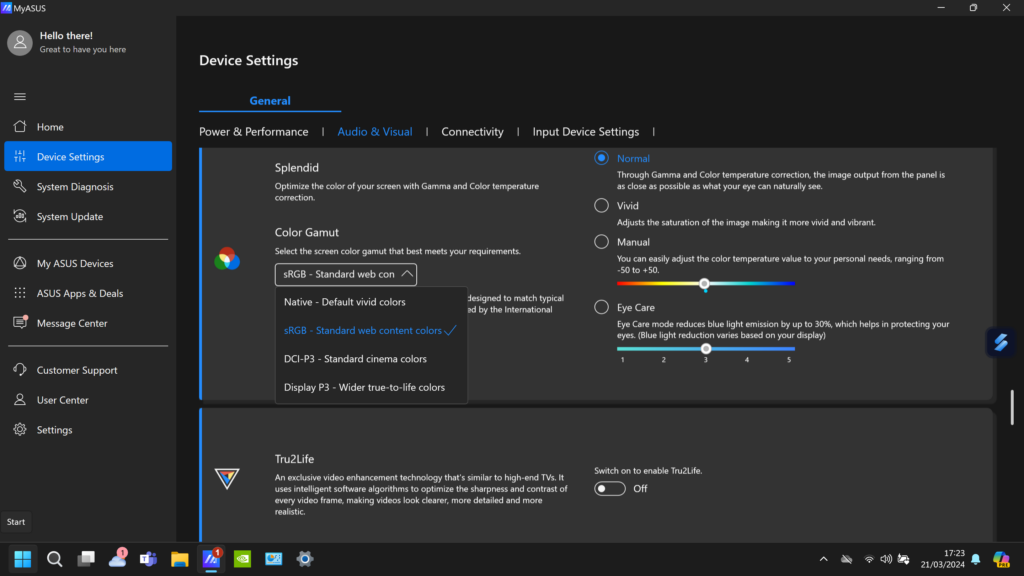
Also included are Dolby’s Access app to improve audio and video playback performance, Asus GlideX, which enables you to share screens across devices even if they don’t run Windows, like an Android or iOS smartphone or tablet, and Asus ScreenXpert, which helps you manage app windows across connected Windows displays.
If you regularly work across connected devices or with more than one monitor, both GlideX and ScreenXpert are genuinely useful tools.
Battery Life
- 75Wh battery gives a good runtime
- Can be recharged via the Thunderbolt 4 port
The PCMark 10 Modern Office battery bench test put the lights out after 8 hours and 2 minutes, which isn’t bad for a laptop with a 75Wh battery. Of course, that’s with the integrated GPU doing all the heavy lifting. With the Nvidia RTX 4050 running, the battery can be drained in a few hours.
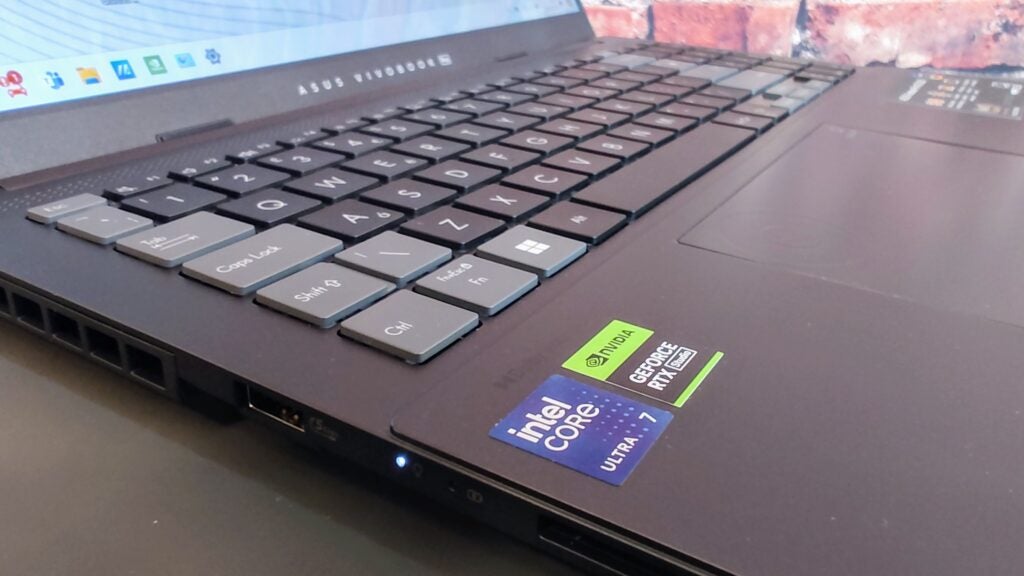
Running a locally stored video file drained the battery of its full charge in just over 9 hours while streaming Netflix for 60 minutes took 12% of the battery. Getting through a full working day is possible, though you will find yourself looking at the battery meter at 6pm, wondering if you should plug it in quickly before leaving the office.
Latest deals
Should you buy it?
If you want a good do-it-all laptop
If you have a grand and a half to spare, very few other laptops do everything as well as the Vivobook Pro 15. From gaming to basic production, design and animation work to professional-standard image rendering, the Vivobook Pro never puts a foot wrong.
If you can’t recharge during the day
Though the Vivobook Pro 15’s battery life is good, it’s only good by Windows and Intel standards. The MacBook Pro, admittedly a far more expensive option, has it beaten hands down.
Final Thoughts
As an all-rounder, the Asus Vivobook Pro comes very close to matching the evergreen Apple MacBook Pro 16. Granted, the MacBook has significantly superior battery life, but so it should: If you want one with a Vivobook-matching 1TB SSD, you’ll be paying almost three grand for the privilege.
The 2024 Asus ROG Zephyrus G16 is worth a look if money is no object. It’s a highly impressive bit of kit, but for four grand in the top-end form that we were sent to review, it should be! If you lean more towards the gaming than the creating side of things, HP’s latest Omen 16 is a well-balanced alternative,
Lenovo’s impressive Yoga Pro 9i is the most direct competitor, which boasts a 3.2K Mini LED touchscreen and a potent Core i9-13905H CPU. The sound system is extremely good, too. Price is an issue, though, with the Yoga Pro 9i costing only a few pence below £2,000/$2,000, and battery life is poor.
If you want a laptop that fully deserves its “Pro” moniker but don’t want to end up light in the wallet to the tune of 2 or 3 grand, the new Vivobook Pro is a slam-dunk, and remember, I’m basing that on the price of the range-topping RTX 4060 model.
How we test
Every laptop we review goes through a series of uniform checks designed to gauge key things, including build quality, performance, screen quality and battery life.
These include formal synthetic benchmarks and scripted tests, plus a series of real-world checks, such as how well it runs popular apps.
FAQs
OLED laptops offer several advantages over traditional liquid crystal display (LCD) laptops. Firstly, OLED displays provide richer and more vivid colours, making images and videos appear more lifelike. Secondly, OLED technology allows for deeper blacks and higher contrast ratios, enhancing the overall visual experience.
Burn-in is possible with OLED but unlikely with normal use. Most “burn-in” is image retention, which goes away after a few minutes. You’ll almost certainly see image retention long before it becomes permanent burn-in. Generally speaking, burn-in is something to be aware of but not worry about.
Trusted Reviews test data
PCMark 10
Cinebench R23 multi core
Cinebench R23 single core
Geekbench 5 single core
Geekbench 5 multi core
Geekbench 6 single core
Geekbench 6 multi core
3DMark Time Spy
CrystalDiskMark Read speed
CrystalDiskMark Write Speed
Brightness (SDR)
Brightness (HDR)
Black level
Contrast ratio
White Visual Colour Temperature
sRGB
Adobe RGB
DCI-P3
PCMark Battery (office)
Battery discharge after 60 minutes of online Netflix playback
Cyberpunk 2077 (Quad HD)
Cyberpunk 2077 (Full HD)
Cyberpunk 2077 (Full HD + RT)
Cyberpunk 2077 (Full HD + Supersampling)
Returnal (Quad HD)
Returnal (Full HD)
F1 22 (Quad HD)
F1 22 (Full HD)
Fan noise under stress
Temperature under stress
Verdict
The multipurpose and omnicompetent Asus Vivobook Pro 15 has no mentionable weaknesses and is excellent value, considering its up-to-date underpinnings and range of features. Creatives, gamers, animators, modellers, and anyone just wanting a top-notch laptop will be hard-pressed to find a better one at the price.
Pros
- Colour-accurate 120Hz OLED screen
- Large, smooth touchpad with Asus DialPad
- Solid, expansive keyboard
- Room for a second SSD
Cons
- 8GB of RAM is soldered
- The I/O port layout is lopsided
Introduction
The new Asus Vivobook Pro 15 is a laptop designed for content creation and graphics-intensive productivity but with useful gaming capacity, thanks to its potent hardware.
The Vivobook Pro 15’s hardware is current, with the option of two Intel Meteor Lake-H CPUs (the Ultra 7 155H or the Ultra 9 185H) and two Nvidia RTX 4000 GPUs, the 4050 and the 4060. No matter which model you buy, you’ll get a very colourful and colour-accurate 3K (2880 x 1620) OLED panel with a 120Hz refresh rate and a MUX switch to unleash the full power of the GPU.
The price for all this tech goodness? The Core Ultra 7 155H RTX 4050 model I’ve tested won’t be ranging in the UK but will cost you $1,299 in the US. For the higher specification, which is coming to the UK, it’ll cost £1,599/$1,699. That’s not a bad price when the obvious competition in the form of Apple’s MacBook Pro 16 will set you back over £1,000 more.
Design and Keyboard
- Rock solid keyboard
- MIL-STD 810H robust
- Room for more storage and memory
The Vivobook Pro 15 is available in just one colourway in the UK, Earl Grey, which logically would be brown rather than grey. Both the colour and the design are rather anonymous. The only part of the proceedings with any glamour is the high-gloss silver Asus Vivobook script on the lid. While the lid is made from metal, the base of the Vivobook Pro 15 is plastic, but it still feels like a solid and premium product.

At 1.8kg the Vivobook Pro 15 is quite light, and at under 20mm thick, it is not too chunky either. Like many Asus laptops, it meets the US MIL-STD 810H standard for resistance to shock, temperature, and particle ingress.
The sides of the Vivobook Pro are home to a generous array of I/O ports. On the right are two Type-C ports, one Thunderbolt 4 spec and one USB 3.2 Gen 2, a 3.2 Gen 1 spec USB-A port, HDMI 2.1, Gigabit Ethernet, 3.5mm audio, and a power jack. On the left, there’s a second USB-A port and an SD 4.0 card reader.

That’s a solid selection, even if the layout is unnecessarily lopsided. Only the Thunderbolt 4 port supports video output, though you can charge via either Type-C if you don’t want to carry the standard 200W Asus power brick around.
With the Intel AX211 wireless card supporting Bluetooth 5.3 and 6GHz Wi-Fi 6E, there’s no need to worry about the modernity of cable-free communications.
The first thing that strikes one about the keyboard is its solidity. You have to press down brutally in the centre to get the slightest flex from the deck. In normal use, it is effectively solid. It’s expansive, too, with a two-thirds-width numeric keyboard. If I had to pick a layout issue, I’d mention the half-height cursor keys.

The black and grey keyboard is easy on the eye, and the colour difference between the grey enter keys, black alphanumeric keys, and numeric keypad isn’t just a question of aesthetics. I found it improved my focus on the central part of the keyboard when typing or the number pad when using that.
The keys have a perfectly judged 1.4mm travel, a comfortable 0.3 mm key-cap dish, and a clean action with a positive end stop. The typing action is silent.
The Asus DialPad is built into the top-left corner of the touchpad and activated by a swipe from the top right. If you want to know more about the DialPad, Asus has created a handy video. In short, it’s a circular controller that gives you fingertip control over your creative apps. For example, you can use it to change brush size. It’s fully customisable and can be used for mundane tasks like adjusting the volume or display brightness.

Getting inside the Vivobook Pro 15 is straightforward, and once open, you’ll find space for a second 2280 PCIe 4 SSD and one free SODIMM RAM slot. With 8GB of RAM soldered to the motherboard, you can load a maximum of another 16GB onto the Vivobook Pro taking the total to 24GB. The Intel AX211 Wi-Fi card is also easily accessible, and the battery can be replaced with just the removal of four Philips screws.
Asus makes no specific claims regarding the Vivobook Pro 15’s environmental impact or lack thereof, but the packing is minimal and made entirely of easily recycled cardboard. You can even disassemble the box lid and fashion it into an impromptu stand, holding the Vivobook Pro vertically or propping the rear up to improve the typing angle.
Display and Sound
- Colour-accurate 120Hz OLED screen
- Loud and punchy sound system
- All-singing, all-dancing webcam
The Samsung-made display is a very impressive 15.6-inch, 16:9 120Hz OLED affair. The 2,880 x 1,620-pixel panel isn’t quite as sharp as the MacBook Pro’s at 212dpi to 254dpi, but the difference is hard to discern with the naked eye. It’s bright, hitting 330nits in SDR mode and 603nits in HDR mode, earning it a VESA DisplayHDR True Black 600 award.
Colour is abundant thanks to the wide gamut coverage of 100% sRGB, 98.6% DCI-P3, and 95.3% Adobe RGB, all validated by Pantone. The display is also superbly accurate, with Delta E variances of just 0.66 vs the Display-P3 profile, 0.91 vs DCI-P3, and 0.7 vs sRGB. Those results are outstandingly good, amongst the best I’ve encountered on any laptop.

HDR performance is hugely impressive, with infinite contrast and superbly saturated colours. Whether just watching a movie or creating content, the Vivobook Pro’s display is a joy to behold, even if it can’t match the searing brightness of the MacBook Pro’s Mini LED display.
Asus claims a 0.2ms response time for the screen and motion fidelity looks excellent, with hardly any discernible ghosting or smearing. Gaming and 3D modelling animations look superb on the Vivobook.
The Vivobook Pro 15’s two Harman Kardon” speakers produce an impressive sound with plenty of bass and detail. The speaker system is loud, too, pumping out 80dB(A) as measured against a pink noise source at a 1m distance.
The webcam is fully featured and outstanding. It can shoot video at a crisp and colourful 1440p and supports Windows Hello IR facial recognition. Thanks to the Intel AI Boost tile that forms part of the Core Ultra 7 CPU, it also comes with Microsoft’s Studio Effects features like background blur, automatic framing, and eye contact.
You also get a physical privacy shutter, and the camera works as a presence detector, so it can dim or turn off the display when you move away and turn it back on when you return.
Performance
- Intel Core Ultra 7 155H and RTX 4050 (115W) combo
- MUX switch for optimal dGPU performance
- Good for FullHD gaming and 3D modeling
The most powerful model for the series is the Core Ultra 9 185H and GeForce RTX 4060 machine, which will soon go on sale for £1,599. My review model is the lesser 155H / RTX 4050 beast; price and UK availability are to be confirmed. Both models come with 16GB of RAM as standard.
With an eye on gaming performance, the RTX 4050 GPU has a healthy 115W TGP, which means you can run even demanding titles like Cyberpunk 2077 and Returnal at decent Full HD speeds, 47 and 48fps, respectively, if you forgo ray tracing. Engage Nvidia’s DLSS3 upscaling and you’ll see those frame rates double.
Moving pixels for business rather than pleasure, the Vivobook Pro 15 scored 75 points in the SPECviewperf 3dsmax workstation 3D modelling test, which compares well with the sort of result I’d expect from a 140W RTX 4060 GPU of 90-95.
The Ultra 7 155H is one of Intel’s very latest models. It has a 4.8GHz, 16-core, 22-thread processor with 6 performance cores. The GeekBench 6 and Cinebench R23 multi-core scores of 12,561 and 16,388 are very healthy and mean the Vivobook Pro 15 is capable of good productivity performance.
My review machine’s 1TB Western Digital SSD proved a rather mundane performer. The sequential read speed of 4,015MB/s was fine, but the corresponding average write speed of 1,985MB/s was somewhat unimpressive for a machine that, by definition, will be used to shunt large media and data files around.
Software
- MyAsus app provides a simple management interface
- Asus Dial Control Panel is a stand-alone feature
- Dolby Access to tune audio and video
The MyAsus app is an intuitive and simple catch-all control panel for managing the Vivobook Pro 15’s sound, performance, and display profiles. It’s especially handy for the latter, letting you easily switch between sRGB, DCI-P3, Display P3, and Native (in SDR mode). MyAsus also houses the MUX switch, which lets you reboot into or out of RTX 4050-only mode.

Also included are Dolby’s Access app to improve audio and video playback performance, Asus GlideX, which enables you to share screens across devices even if they don’t run Windows, like an Android or iOS smartphone or tablet, and Asus ScreenXpert, which helps you manage app windows across connected Windows displays.
If you regularly work across connected devices or with more than one monitor, both GlideX and ScreenXpert are genuinely useful tools.
Battery Life
- 75Wh battery gives a good runtime
- Can be recharged via the Thunderbolt 4 port
The PCMark 10 Modern Office battery bench test put the lights out after 8 hours and 2 minutes, which isn’t bad for a laptop with a 75Wh battery. Of course, that’s with the integrated GPU doing all the heavy lifting. With the Nvidia RTX 4050 running, the battery can be drained in a few hours.

Running a locally stored video file drained the battery of its full charge in just over 9 hours while streaming Netflix for 60 minutes took 12% of the battery. Getting through a full working day is possible, though you will find yourself looking at the battery meter at 6pm, wondering if you should plug it in quickly before leaving the office.
Latest deals
Should you buy it?
If you want a good do-it-all laptop
If you have a grand and a half to spare, very few other laptops do everything as well as the Vivobook Pro 15. From gaming to basic production, design and animation work to professional-standard image rendering, the Vivobook Pro never puts a foot wrong.
If you can’t recharge during the day
Though the Vivobook Pro 15’s battery life is good, it’s only good by Windows and Intel standards. The MacBook Pro, admittedly a far more expensive option, has it beaten hands down.
Final Thoughts
As an all-rounder, the Asus Vivobook Pro comes very close to matching the evergreen Apple MacBook Pro 16. Granted, the MacBook has significantly superior battery life, but so it should: If you want one with a Vivobook-matching 1TB SSD, you’ll be paying almost three grand for the privilege.
The 2024 Asus ROG Zephyrus G16 is worth a look if money is no object. It’s a highly impressive bit of kit, but for four grand in the top-end form that we were sent to review, it should be! If you lean more towards the gaming than the creating side of things, HP’s latest Omen 16 is a well-balanced alternative,
Lenovo’s impressive Yoga Pro 9i is the most direct competitor, which boasts a 3.2K Mini LED touchscreen and a potent Core i9-13905H CPU. The sound system is extremely good, too. Price is an issue, though, with the Yoga Pro 9i costing only a few pence below £2,000/$2,000, and battery life is poor.
If you want a laptop that fully deserves its “Pro” moniker but don’t want to end up light in the wallet to the tune of 2 or 3 grand, the new Vivobook Pro is a slam-dunk, and remember, I’m basing that on the price of the range-topping RTX 4060 model.
How we test
Every laptop we review goes through a series of uniform checks designed to gauge key things, including build quality, performance, screen quality and battery life.
These include formal synthetic benchmarks and scripted tests, plus a series of real-world checks, such as how well it runs popular apps.
FAQs
OLED laptops offer several advantages over traditional liquid crystal display (LCD) laptops. Firstly, OLED displays provide richer and more vivid colours, making images and videos appear more lifelike. Secondly, OLED technology allows for deeper blacks and higher contrast ratios, enhancing the overall visual experience.
Burn-in is possible with OLED but unlikely with normal use. Most “burn-in” is image retention, which goes away after a few minutes. You’ll almost certainly see image retention long before it becomes permanent burn-in. Generally speaking, burn-in is something to be aware of but not worry about.
Trusted Reviews test data
PCMark 10
Cinebench R23 multi core
Cinebench R23 single core
Geekbench 5 single core
Geekbench 5 multi core
Geekbench 6 single core
Geekbench 6 multi core
3DMark Time Spy
CrystalDiskMark Read speed
CrystalDiskMark Write Speed
Brightness (SDR)
Brightness (HDR)
Black level
Contrast ratio
White Visual Colour Temperature
sRGB
Adobe RGB
DCI-P3
PCMark Battery (office)
Battery discharge after 60 minutes of online Netflix playback
Cyberpunk 2077 (Quad HD)
Cyberpunk 2077 (Full HD)
Cyberpunk 2077 (Full HD + RT)
Cyberpunk 2077 (Full HD + Supersampling)
Returnal (Quad HD)
Returnal (Full HD)
F1 22 (Quad HD)
F1 22 (Full HD)
Fan noise under stress
Temperature under stress
























